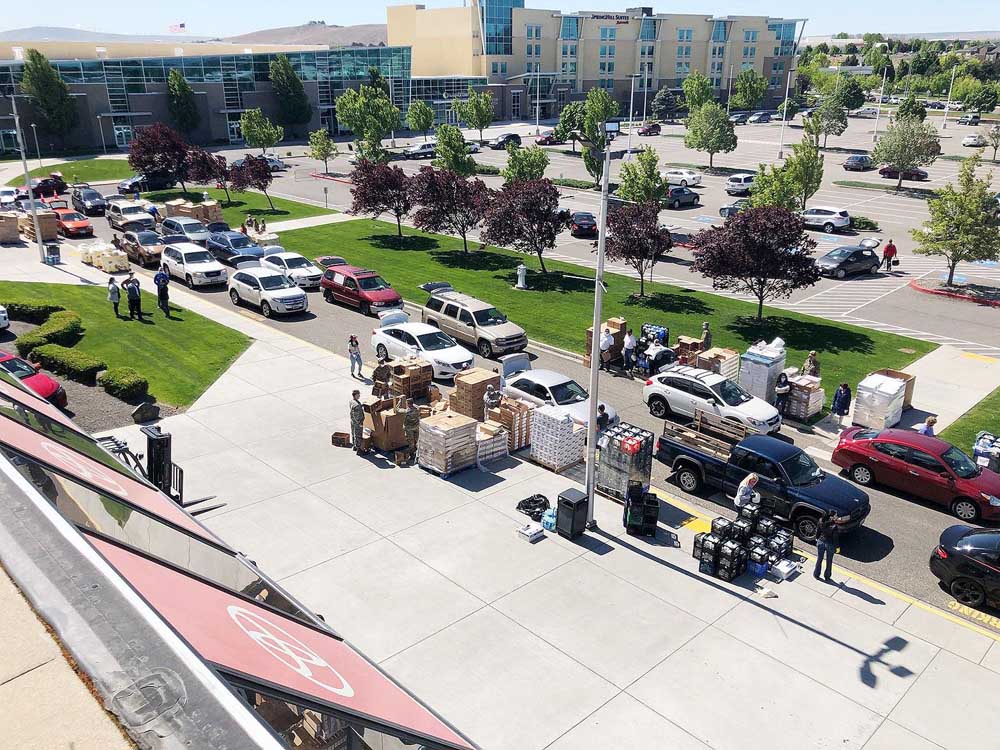Virus changes how US feeds hungry
Published 10:37 am Wednesday, July 1, 2020

- A line of cars waits at a Washington state food bank.
In June, according to Feeding America, more than 54 million people in the U.S. faced hunger: more than at the peak of the Great Recession.
Farmers, processors, food banks and governments are working to fill the gap. But experts say COVID-19 has “upended” how hunger relief systems operate and will likely leave lasting changes.
Food banks across the West say their biggest COVID-19 challenge has been losing volunteers.
America’s hunger relief system is volunteer-driven, and the majority of pre-pandemic volunteers were older adults.
When COVID-19 hit, Aaron Czyzewski, director of advocacy and public policy at Food Lifeline, a Washington state anti-hunger group, said volunteer teams disappeared “almost overnight” as people self-quarantined.
The National Guard swooped in to help — and food banks say guardsmen are leaving a legacy of more efficient processes — but come the end of July, the National Guard will withdraw, leaving a void for “desperately needed” volunteers.
Across the U.S., many people have blamed farmers for dumping milk and produce during the pandemic. But food bank leaders say it’s not farmers’ fault; most food banks simply don’t have volunteers to handle bulk farm donations.
Volunteers aren’t the only thing that disappeared.
When lockdowns started, said Czyzewski, Food Lifeline’s food donations fell by 90%. Food bank leaders across the West echoed this, saying the early rush on grocery stores left retailers with little to donate.
Food banks in Oregon, Washington state, Idaho and California told the Capital Press their most consistent donors, both before and during the pandemic, have been farmers.
State aid has also provided relief, along with the U.S. Department of Agriculture’s Farmers to Families Food Box Program, a $3 billion slice of the federal CARES Act, which buys farm food from regional processors, which then donate to food banks.
Drew Meuer, chief of staff at Second Harvest, a hunger relief organization in Washington state, said families have expressed their excitement about the high-quality produce.
But some worry USDA’s food box program may unravel farm-to-food bank relationships.
Andrew Cheyne, director of government affairs at the California Association of Food Banks, said although he’s grateful for the program, it may hurt relationships with existing donors.
The program awards processors, such as fruit companies, with contracts. The unintended consequence, Cheyne said, is that because of food banks’ limited capacity, existing farm-donors are being pushed aside by new USDA contractors because many food banks under strain can no longer handle bulk farm donations.
“We’re concerned it could be really disruptive to the longer-term relationships we’ve built,” Cheyne said.
Washington state food banks are seeing similar displacement of long-time donors, but Susanne Lally, spokeswoman at the Idaho Foodbank, said it’s too early to tell.
Jen Turner, Oregon Food Bank’s program expert, said Oregon is having better luck because many of the distributors USDA selected already had relationships with Oregon Food Bank, making the transition more seamless.
But even Oregon farms have seen disruptions.
John Burt, executive director of the Oregon nonprofit Farmers Ending Hunger, said when USDA’s food box program ends in December, he’ll likely need to recreate donation supply chains and restart fundraising.
“Where’s our place in all this?” said Burt. “I kind of feel like the odd man out and I wonder what the future looks like.”
‘Less bureaucracy’
Food bank leaders say although federal agencies have tightened some restrictions during COVID-19, they have loosened many others.
One food bank leader who chose not to be identified said having “a lot less bureaucracy” has allowed the organization to operate more efficiently.
“Because of the pandemic, it seems like we have ten years’ worth of advocacy accomplishments delivered to us in a matter of months,” said Czyzewski.
Matt Newell-Ching, policy manager on Oregon Food Bank’s advocacy team, said a recent federal waiver has given more flexibility to summer meal programs, which used to feed people only on-site and now offer grab-and-go options. Newell-Ching said the flexibility has overall been “very positive,” although it has drawbacks — such as added costs for Ziploc bags.
Early during COVID-19, low-income families were given waivers to access the Special Supplemental Nutrition Program for Women, Infants and Children, or WIC for short. Senate Agriculture Committee Chairman Pat Roberts, R-Kan., and Sen. Debbie Stabenow, D-Mich., urged USDA to extend the WIC waivers through Sept. 30 and were granted their request Monday.
Congress also created the Pandemic Electronic Benefits Transfer program, or P-EBT, which gives families with schoolchildren a one-time benefit payment to offset lost free or subsidized school meals. Anti-hunger groups are pressing Congress to extend the program.
Ninety-nine food banks across nationwide are calling for further changes: for Congress to approve a 15% increase in SNAP benefits for the duration of the recession, increase the minimum SNAP household benefit from $16 to $30 per month and channel funding for increased food bank cold storage.
Although some economists have criticized SNAP as “unsustainable,” some think tanks, including the Cato Institute, told the Capital Press their researchers are not yet available to take a policy stance on how to handle the food funding crisis.
“It’s not reasonable for us to expect all of these changes to stick, but it sure would be nice,” said Czyzewski. “I worked in cancer advocacy before this, and I thought: what could be more complicated than cancer? But food insecurity — it’s really complex. As we come out of COVID, I think a lot will change about how farms and food banks fight hunger.”





